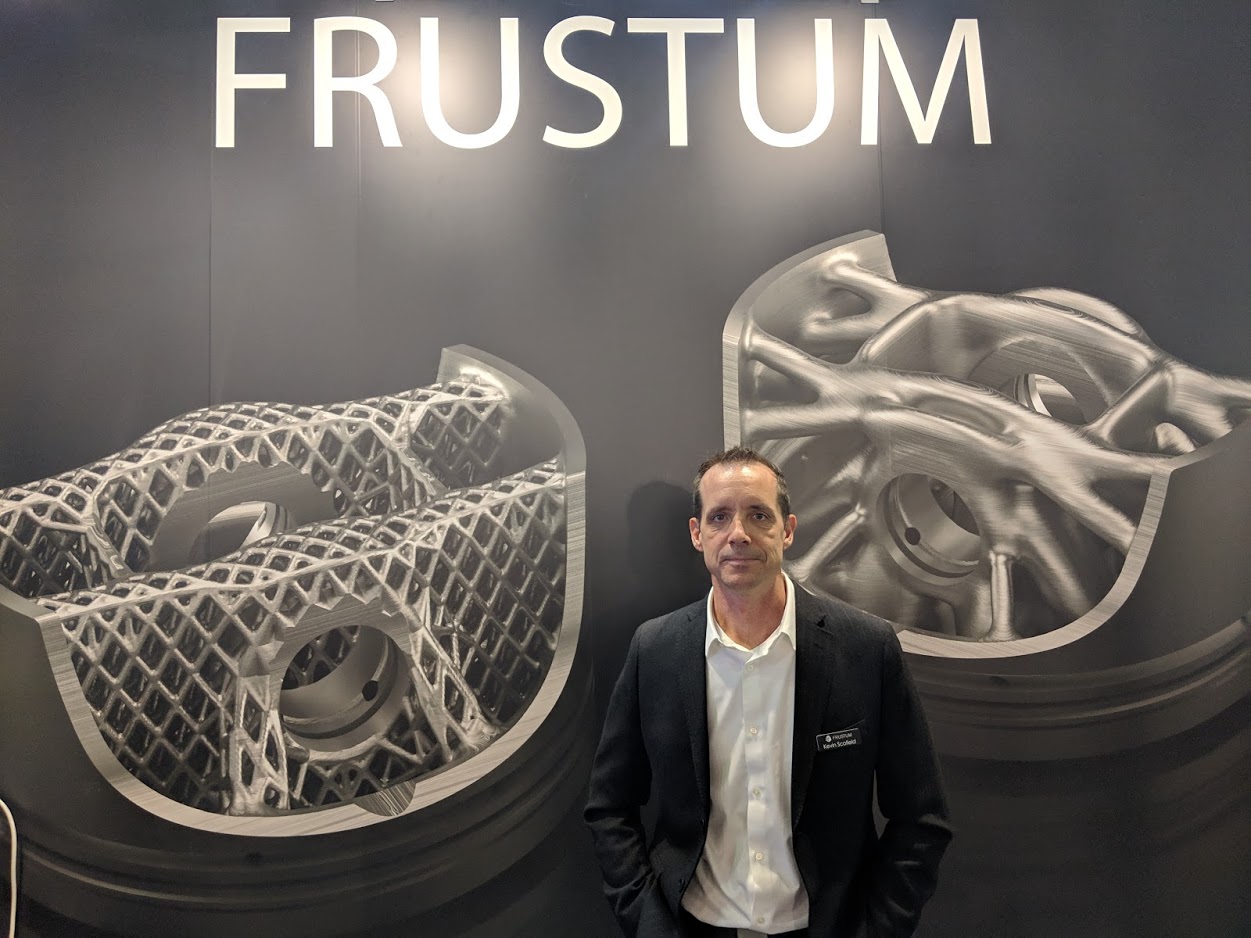![Kevin Scofield, VP Technical Marketing, Frustum at formnext 2018 [Image: Fabbaloo]](https://fabbaloo.com/wp-content/uploads/2020/05/IMG_20181114_132617_img_5eb0a2513a13d.jpg)
Frustum has been busy with new releases — and today with a new parent company.
Last month, Frustum introduced GENERATE for Windows, enhancing its product portfolio. Today, the company announces that it has now become a portfolio expansion itself as PTC has acquired the company.
To get a clear view of Frustum’s strategies, I sat down last week at formnext with the company’s VP of Technical Marketing, Kevin Scofield, for a chat about the company’s ambitions and strategies.
“Frustum is trying to take a leadership role in generative design, mainly in additive manufacturing. A lot of people are doing lattice, gyro, and now meso-structures, but these aren’t always suited for actual manufacturing. This is not trivial: a strength of ours is blending generative geometries with existing geometries. The real value is in taking it real, and this is now manifesting as a standalone product,” Scofield told me.
The Boulder, Colorado-based company has “a lot of faithful users,” some of whom are now converting from the cloud to Windows with that capability now possible. Frustum leverages GPU “to accelerate processes to near real-time,” Scofield explained, as users can “watch in real time, with truly interactive generative design.”
As many have commented, the thousands of visitors to formnext represent a highly-informed crowd of users and providers, and each year these crowds come equipped with even firmer bases of knowledge. This more focused interest, as Scofield put it, means that more people are familiar with generative design — which the Frustum team found themselves explaining even as recently as this spring’s RAPID + TCT event.
“In a short time, we’re seeing more education around generative design, and more tools out there,” he said.
An important aspect of Frustum’s approach is to take non-manufacturable output from other generative design providers and enable manufacturability, taking this as throughout the production process through to post-processing. Their generative design capabilities also enable production with traditional subtractive technologies, with Scofield noting especially interesting results with water jetting, “but it’s really geared toward additive manufacturing.”
At formnext, the response was very positive; Frustum was exhibiting for the first time at the Frankfurt show, and saw “interest from large corporations, particularly from tech innovation labs and people who said, ‘My boss said go look at additive’.”
With generative design picking up in both awareness and availability, Frustum is by no means the only name in the generative game. Distilling differentiation, Scofield noted, is important, and for Frustum that means near real-time capabilities.
“Watching the design change before your eyes in near real-time shortens design time considerably. Running it locally, our streamlined API works with computer drives, leveraging GPU, which is important for us,” he said.
Industry-wise, Frustum works with users in aerospace, automotive, and “surprisingly a lot of consumer products” such as footwear and eyewear, where aesthetics matter. Among notable customers are Honeywell Aerospace and Stanley Black & Decker, as “tooling has seen a lot of growth.”
“We’re friendly with, and partners with, a lot of printer companies,” Scofield added. “We get to know the capabilities for angles possible and what each system can really do. There’s a lot of interest, especially here, in process simulation, and an awareness of the entire process chain. With simple feedback, we can tailor results.”
A key element for Frustum is tying output back to CAD, which still poses a challenge for additive manufacturing users and where there are “not a lot of elegant solutions.”
Adding on to the conversation with Frustum is today’s acquisition announcement.
The approximately $70 million deal, which closed yesterday, sees Frustum’s technology added in to the PTC Creo portfolio. PTC notes that “the acquisition is not expected to add material revenue for 2019 or to be dilutive to the financial guidance PTC provided on Oct. 24, 2018.”
PTC strategically partnered with ANSYS earlier this year to offer an integrated solution for Creo. PTC’s President and CEO, Jim Heppelmann, noted of the growing capabilities:
“Creo is core to PTC’s overall strategy, and the embedded capabilities from ANSYS and, later, Frustum will elevate Creo to a leading position in the world of design and simulation. With breakthrough new technologies such as AR/VR, high-performance computing, IoT, AI, and additive manufacturing entering the picture, the CAD industry is going through a renaissance period, and PTC is committed to leading the way.”
Of the strategic benefits and positioning of the full solution, PTC’s announcement explains:
“Frustum complements PTC’s strategic relationship with ANSYS, which was announced at LiveWorx in June 2018, and will bring analysis upstream to the very start of the design process. With embedded Frustum and ANSYS capabilities, Creo will be able to recommend design approaches using generative design, guide the user through the iterative design process using ANSYS Discovery Live, and ultimately validate the full product design at scale using the broader ANSYS Discovery suite. With these capabilities embedded in Creo, engineers will have unmatched capabilities to rapidly drive product innovation.”

